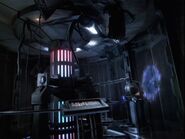The Nova-class was a type of Federation starship designed for short-term planetary research missions. It was placed in service starting in the mid-to-late 24th century.
History
In 2370, some Nova-class starships were constructed in the Sol system at the Utopia Planitia Fleet Yards, around stardate 47007.1. USS Equinox was constructed and launched at this time. (VOY: "Equinox", "Equinox, Part II" dedication plaque)
Schematics of the Nova-class were contained in the 31st century database kept by temporal agent Daniels aboard the Enterprise NX-01. They were viewed by Captain Jonathan Archer and Lieutenant Malcolm Reed who accessed his database in 2151. (ENT: "Shockwave") They were later viewed by Archer and T'Pol in Daniels' database the following year. (ENT: "Future Tense")
In an alternate 2404, a refit of the Nova-class was in use. The interior of the ship was almost the same, however, the exterior had a number of changes. The refit also had superior tactical firepower and shield strength to that of its predecessor. (VOY: "Endgame")
In another timeline, the refit of this class was still in use during the 26th century by the Federation and was involved in the pivotal Battle of Procyon V. (ENT: "Azati Prime")
Technical data
The Nova-class was designed as a science and scout vessel, intended for short-term planetary research and analysis. It is not typically suitable for combat operations. The Nova design has a maximum speed of warp 8 and approximately eighty crewmembers. One unique feature of the Nova-class is its Waverider shuttle, which is located in a special docking port on the ventral side of the primary hull, similar to that of the Aeroshuttle on the Template:ShipClass.
Physical arrangement
The Nova-class had a design similar to that of an Intrepid-class starship, though smaller in size. It consisted of a saucer section with a curved triangular shape. The secondary hull was directly attached to the underside of the saucer with two warp nacelles.
Unlike some starship designs, the Nova-class only featured one impulse drive, located at the aft end of deck 2 aligned center to the ship.
Tactical systems
Though Novas were science vessels, they had a wide assortment of weaponry, allowing the vessel to handle many threats on its own. It was equipped with eleven strategically-placed phaser arrays: eight on the saucer and three on the secondary hull, two forward-facing photon torpedo launchers at the bow of the saucer opposite of the secondary deflector, and one aft-facing launcher.
The shields of a Nova-class ship
In order to prevent space debris and objects from colliding and damaging the vessel, Nova-class vessels, like other Starfleet vessels, were equipped with a navigational deflector at the bow of the secondary hull. If the main deflector was damaged or disabled, a secondary deflector on the saucer could substitute the main deflector.
Like most Starfleet vessels, the Nova-class was also equipped with a deflector shield for defensive purposes. Shields on a Nova-class could be fully recharged after charging the shield emitters for 45 seconds. This task required the shields to be dropped. The shield grid itself was located along the secondary hull.
Interior design
Though a small ship, the Nova class was able to accommodate the needs of the crew. This class of starship had eight decks.
- See: Nova class decks
Main bridge
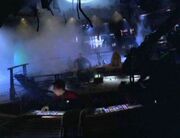
Bridge of USS Equinox
The main bridge, located near the center of deck 1, was the command center for the ship. Despite the size of the ship, the spacious bridge allowed for the ease of movement between stations.
The central command area on the bridge was at the very center of the circular area in a submerged location. The captain's chair was starboard side, and the executive officer's was on the port side. Between them was a console built into the structure that provided a place for information dissemination, as well as operational command of the starship. Directly ahead of the command area and down into a further sunken area, was the conn.
The rest of the stations were located on the perimeter of the round bridge, including the master systems display behind the command seats and the main viewscreen in the standard frontwards position. Stations, such as tactical, were not stand-out stations due to the scientific nature of the design. When necessary, Tactical would usually be assigned to the forward, starboard side console just right of the main viewscreen.
Entryways to the bridge were located at the port and starboard sides on the upper level. The port door leads to the main turbolift while the starboard door leads to a corridor that accesses other sections of deck 1. Access to the captain's ready room was also located on port side.
Main engineering
Main engineering was located on deck 7. The Nova-class engineering section only spanned one deck, and featured four wall based engineering consoles and a warp core analysis console in front of the core itself. At the far end of the room was the warp core with a transparent floor and support railing around it. The core spanned from decks 5-8 and could be ejected from the bottom of the ship through an ejection hatch. The core could be accessed from either engineering or from the maintenance areas around the core.
Sickbay and science labs
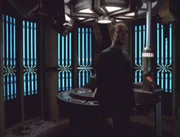
Science lab of USS Equinox
The Nova-class had one sickbay located on deck 4, in front of the shuttlebay. The Nova-class medical facility was equipped with an Emergency Medical Hologram system, like the one on USS Voyager.
Additionally, as a science vessel, the Nova-class was equipped with a number of specially-equipped science and research labs. The labs were similar to those found on an Intrepid-class vessel and served many purposes and supported numerous personnel. They featured a great number of work consoles to perform numerous tasks and had one main work console area in an alcove.
Auxiliary craft and cargo bays
Behind the main sickbay were the 2 shuttlebays. The aft-most shuttlebay's space doors are directly aft (similar to the Template:ShipClass). The inner shuttlebay's doors open directly above [2]. An additional view of the secondary shuttlebay can be seen here [3] (the aft-most black rectangle on the dorsal side of the ship).
In the saucer on deck 4, a short trip from the shuttle bays, was the aforementioned Waverider auxiliary craft, which was integrated into the Nova-class' hull. Spanning decks 2 and 3 in front of the shuttlebay were the main cargo bays which could also contained CMUs, used for transportation and repair purposes.
Additionally, like a majority of starships in the 24th century, Nova-classes were equipped with emergency escape pods, twenty in total; fourteen were located on deck 3, four on deck 1 and two on deck 2, all located in the saucer section. They were stored under hatches to permit both launch and retrieval.
Crew quarters
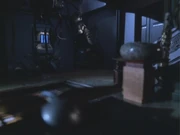
Captain's quarters of the USS Equinox
Due to the size of this class, crew quarters were spartan, but provided all the standard needs for the crew. A majority of the quarters were standard crew quarters, though a number of them were larger for use by the senior staff. The majority of these larger quarters were located on decks 1 and 4, with slightly smaller ones located on decks 2 and 6.
Ships commissioned
- Named
- USS Equinox (NCC-72381)
- USS Rhode Island (NCC-72701)
- Uncertain
- USS Nova (NCC-73515)
- Unnamed
Appendices
Appearances
- VOY:
- "Equinox"
- "Equinox, Part II"
- "Endgame"
- ENT:
- "Shockwave" (database display)
- "Future Tense" (database display)
- "Azati Prime"
Background
According to Star Trek: The Next Generation Technical Manual, the Nova-class is the successor of the Template:ShipClass starship as the next primary explorer ship of Starfleet. Four different concept designs were presented on pages 177 and 178. The direction the actual Nova-class eventually followed was the down-sized ship with less internal volume that allowed each ship to be refitted for specific mission types and an angular-curvilinear shape designed to allow an enhaced utilization of warp energy.
One of the other designs that was not followed featured variable geometry pylons that ended up to be featured on the Template:ShipClass. Another design featured an elliptical saucer section extended steeply toward port and starboard, a shape intended to enhace the peak transitional efficiency of a high-frequency warp envelope. This feature was eventually featured on the USS Enterprise-J. It was also stated that the USS Enterprise-E might end up being of this class, but a ship of the Template:ShipClass was given the name. (VOY: "Caretaker";ENT: "Azati Prime";Star Trek: First Contact)
According to the Star Trek: Starship Spotter, the ship was equipped with only two cargo management units and two shuttlecraft. The phaser arrays were classified as Type X, the same as the Galaxy-class and Intrepid-class phasers. The ship had a mass of 110,000 metric tonnes.
Studio model
Design
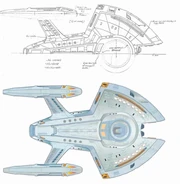
USS Defiant Pathfinder Project
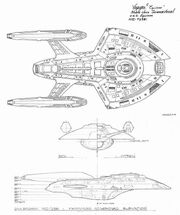
Template:ShipClass design sketch and orthographic views
The final Nova-class starship model was created by Rick Sternbach for "Equinox". It is based on the USS Defiant Pathfinder design, whose top view is depicted in the Star Trek: Deep Space Nine Technical Manual. The Pathfinder was part of the background story in the Manual Sternbach devised to describe the design history of what was to become the Template:ShipClass. Sternbach, using tracing paper over the Defiant design for a basic sketch of the design, drew half a nacelle and half a ship body with a centreline which could be flop-copied. The sketch was turned over to Doug Drexler who produced the final drawing for the Manual.
When asked to come up with a new design for a new small science vessel, Sternbach first considered doing a refit of the Template:ShipClass, but dismissed the idea since that design was over 80 years old. He then recalled the design he had done for the Manual a year earlier,"The Nova class U.S.S. Equinox began as a small pencil drawing of a ship that was to have been the space-going equivalent of a PT boat in the Alpha and Beta Quadrant theatres. In the fictional history of the U.S.S. Defiant, as recorded in the DS9 Technical Manual, a fast and heavily armed "Borg Buster" with multiple torpedo launchers was modified with tucked-in engines and new ablative armour to fight the Cardassians, the Jem'Hadar, and the Dominion, among various other Alpha Quadrant baddies. The pathfinder form of that fast attack ship existed as a single top view until one day when the Voyager script "Equinox" appeared. It called for a new science vessel that had also been unceremoniously yanked into the Delta Quadrant by – guess who – the Caretaker."[4] Sternbach devised a background story elaborating on the history he had done for the Manual where the shelved Pathfinder hull design was re-appraised by the ASDB (Advanced Starship Design Bureau-the name Sternbach came up with to signify the research and development arm of Starfleet) for it to become the Template:ShipClass. He submitted the idea and a copy of the Pathfinder drawing to supervising producer Peter Lauritson, who gave his approval thereby affirming that "the Defiant pathfinder was definitely the origin of the Equinox, in production as well as in non-canon backstory."[5]
On fine-tuning the design, Sternbach remarked:
The design followed the basic Starfleet plan of a forward hull, engineering hull, and nacelles on pylons, though most of the shapes were given sharper edges and angles. I incorporated some stylistic elements from John Eaves' Enterprise-E as a possible ASDB "sibling", particularly in the pylon plasma flush vents and Bussard collectors. I also gave a tip o' the hat to Todd Guenther with the notching of the forward hull, a feature he employed in his home grown volumes "Ships of the Star Fleet." The design cycle was almost as complex as that for Voyager herself, with ortho preliminaries and final blueprints, and perspective line art and detail sketches. The phaser strips were redesigned. I continued the trend of giving some Starfleet ships a large shuttle-like embedded craft, as Andy Probert did with the captain's yacht on the Enterprise-D, John Eaves did on Enterprise-E, and I did with the Aeroshuttle on Voyager. The arrow-shaped craft on the Equinox underside is a hypersonic "waverider" shuttle, a highly fuel-efficient vehicle at Mach 5 and above. Tim Earls, a set designer on "Voyager" and a veteran of "Babylon 5" and later "Serenity," contributed a preliminary set of elevation views that helped nail the overall mass of the vessel and the creation of the cutaway graphic.[6]
More windows were added to the Pathfinder design, along with a new exterior bridge design. The Pathfinder design featured two forward-facing torpedo tubes where the auxiliary deflector was to be located and were moved beside the deflector in Sternback's Nova. (Although Star Trek: Starship Spotter lists the Nova as having only two torpedo launchers, the design probably has at least three because the Equinox fired an aft torpedo in "Equinox, Part II".} Sternbach also envisioned the Equinox of having landing capabilities akin to the Template:ShipClass,"The three door-like things are retracted landing feet, yep. The other objects are RCS, as you surmised. On the CG render there seems to be a half-round V-shaped dimensional "fence" on the waverider belly, which is probably just an interpretation of a soft break in the belly shape in the blueprint. Not my doing, but I'll accept it as some type of structural reinforcement or active boundary layer controller."[7]
CGI model

CGI models of both Template:ShipClass variants.
In March 1999 Sternbach's design received final approval from the effects supervisors and the design was sent to Digital Muse, where Eddie Robison built and animated the model in LightWave 3D software. Robison kept in contact with Sternbach during the build in order to iron out detailing and the finished ship was a very close approximation to the design as conceived. "The CG model was initially built pristine, and then the textures were altered to look burnt and broken. From what I've seen in LightWave, you can subdivide a group of polygons where, say, you want to make it appear that a phaser hit has smashed away bits of the hull plating, and remove or distort those polygons until they look twisted, vaporized, and so on. Some of the digital modelling tools are quite remarkable.", Sternbach further noted.(Star Trek: The Magazine Volume 1, Issue 14, page 21)
The Nova-class refit that appeared in "Endgame" featured many changes, performance or visual-wise. Additions include a dome added to Bridge, impulse engines combined to one reactor on deck 1 and its auxiliary deflector reduced greatly, triangular shaped. The gap in front of it is filled in. Portions of the Bussard collectors were covered by hull plating and the dorsal intercoolers were reduced to one on each warp nacelle from two. Finally, the ship's escape pods were replaced with pods from the Template:ShipClass. Modifications and remapping were done by Robert Bonchune at Foundation Imaging who remarked,"I did not come up with the name, but was allowed to come up with the NCC number and do whatever I liked to the shape. I always liked the ship, kind of like a small corvette Starship and I figured in a future time it would have been smoothed out and more organic. I also tried to tie it in to the Enterprise-E(or a Standard Starship) in some ways in terms of smoothness and escape hatches, intercoolers etc. I tried to make her look like she was moving fast and slick even standing still. I was going to make other changes to the bottom, but ran out of time for the show. (One reason why I shot her in the scenes from the top as much as possible) We had SO much to do on that finally, it was mind boggling!"[8] Unlike with the Intrepid-class, for which Bonchune built the Aeroshuttle, the waverider was not further explored,"I don't remember doing the shuttle for it. I know I did some textures and such, but not the design/model itself."[9]
Conceived well into the CGI age, no physical production model was ever constructed of the design.
References
- "Designing the U.S.S. Equinox", Star Trek: The Magazine Volume 1, Issue 14, June 2000
- Star Trek: Starship Spotter, Adam "Mojo" Lebowitz & Robert Bonchune, New York: Pocket Books, 2001, ISBN 074343725X
External link
- "Designing the U.S.S. Equinox" article at StarshipDatalink.net
- "Rick Sternbach's Equinox" at Drex Files


